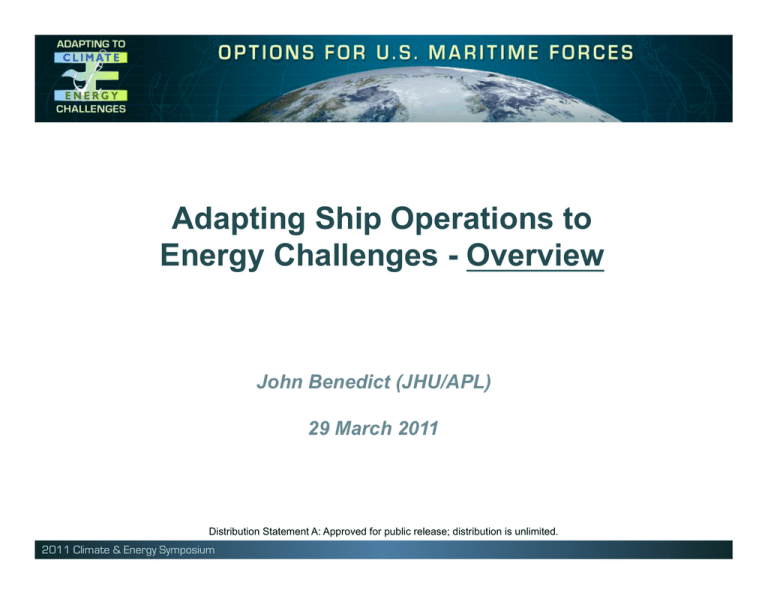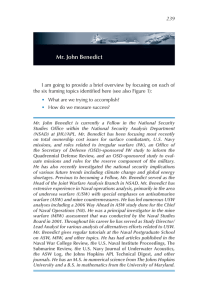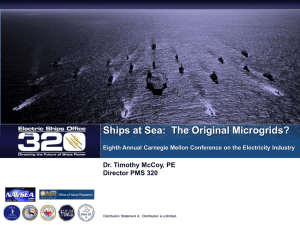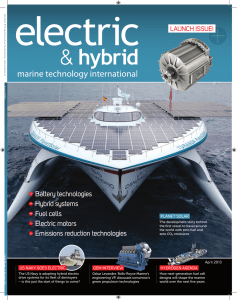Adapting Ship Operations to Energy Challenges - Overview John Benedict (JHU/APL)
advertisement

Adapting Ship Operations to Energy Challenges - Overview John Benedict (JHU/APL) 29 March 2011 Distribution Statement A: Approved for public release; distribution is unlimited. 2011 Climate & Energy Symposium Adapting Ship Ops to Energy Challenges Overview I. Energy, Power &Propulsion Vision/Objectives What are we trying to accomplish? II. Metrics: Return on Investment How do we measure success? What “enablers” are we relying on? III. Enabling Technologies IV. Acquisition Initiatives Can we transition to key acquisition programs? What impact will we ultimately have? V. Operational (and Strategic) Impact What worries should keep us awake at night? 2011 Climate & Energy Symposium VII. Concerns/ Issues/ Risks to Manage 2 I. Energy, Power & Propulsion Vision/ Objectives Strategic Objectives • Partner w/ other Services, government, industry & academia to strengthen energy security at Navy, Joint & National levels • Protect access to energy sources for our Nation & our Allies (i.e., secure, sufficient, reliable, sustainable energy) Operational Objectives • Employ energy efficiency as a force multiplier for both enhanced combat capability & a reduced logistics tail • Reduce full logistics tether through operational & technological modifications • Reduce operational risks for logistics, while saving time, money & lives, enhancing both operational flexibility & sustainability • Maintain a long-term perspective wrt energy security accounting for future mission reqs, force structure & • Rely on diversified energy OPTEMPO sources for enhanced • Conserve energy, Tactical (and military operation efficiency/ develop alternative resilience Technical) Objectives energy options, • Incorporate energy requirements in all phases secure energy of system development & acquisition, i.e., distribution & energy efficient acquisition reduce GHG • Rapid adoption of technology & improved TTPs (tactics, emissions techniques & procedures) for energy efficiency • Spearhead early testing and adaptation of viable alternative energy sources, e.g., alternative fuels seamlessly interchanged with petroleum-based fuel 2011 Climate & Energy Symposium 3 II. Potential Metrics – Return on Investment From a Recent Military Operations Research Society (MORS) Special Meeting on Power & Energy (P&E): • A consistent methodology/ framework (e.g., data, metrics, terminology, logic) is needed to address P&E wrt operational effectiveness across the spectrum of required models • M&S tools should be updated accordingly to keep pace with developing P&E technologies • The elements of Fully Burdened Cost of Fuel (FBCF)* or Energy (FBCF(E)) should be decomposed, defined, and standardized to provide a common understanding (e.g., for the force protection/attrition part of FBCF) • Analytic methods are required to derive Energy Efficiency KPPs** & FBCF & should be employed to set capability & cost metrics (objectives/ thresholds) for acquisition programs • Bottom line: Analytic tools & metrics are needed to provide a balanced view of total ownership costs, risks, and capabilities for P&E in support of decision-makers * Definition according to ODUSD Acquisition & Technology is: “FBCF is the commodity price plus the total life cycle cost of all people & assets required to move & protect fuel from the point of sale to the end user.” Note: FBCF use in life cycle O&S has been codified in DoD 5000.02 ** Energy Efficient Key Performance Parameters (KPPs) are called out in CJCS 3170.01F to be “selectively implemented” – slowly being applied to programs 2011 Climate & Energy Symposium 4 III. Illustrative Enabling Technologies for Energy/ Power/ Propulsion • Improved prime mover efficiencies, e.g., combined diesel & gas turbine plants and podded propulsion for new ship designs • Hybrid electric drive (HED) for greater efficiency at low speeds & low electric loads • New/ alternative fuels, e.g., sustainable non-petroleum based fuel • Rechargeable high capacity energy storage, e.g., advanced battery & capacitors to enable ultrahigh power & energy densities • New/ improved hull forms & designs for greater efficiencies at various speeds and increased range/ endurance • Advanced propeller designs/ improved propulsive efficiency • Efficient energy & power conversion, e.g., high power density electrical power conversion & thermal management • Improved power generation, e.g., advanced gas turbine engines/ generators, high efficiency/ reliable /high power density fuel cell systems • High energy & pulsed power load development for advanced combat systems • All electric ship power control & distribution, i.e., integration of ship service electrical power & propulsive power for greater overall efficiency by using same distribution system (e.g., for pulsed power switching & control system ISO advanced weapon systems) • Nuclear power/ propulsion 2011 Climate & Energy Symposium 5 IV. Illustrative Acquisition Initiatives for Energy/ Power/ Propulsion • USS Makin Island (LHD 8) w/ an electric auxiliary propulsion system that enables efficient low speed operations (up to 75% of time deployed) • Goal for hybrid electric drive (HED) on DDG-51 (USS Truxtun) by 2012 (as part of a “proof of concept”) w/ potential cost savings at low speeds • Increased use of biofuels in Fleet w/ ambitious time-phased goals: • 2012: Green Strike Group w/ all ships certified to run on 50/50 biofuel blend • 2016: Green Strike Fleet w/ all ships containing full load out of biofuel plus HED DDG • 2020: 50% of DoN energy consumption will come from alternative energy sources • Other fleet energy efficiency & conservation initiatives, e.g., • “Energy dashboard” to monitor power & fuel consumption • Smart voyage planning software for all ships • Expanded use of synthetic training for ships to reduce fuel consumption • Combustion trim loop on L-ships • Stern flaps, bulbous bows, hull & propeller coatings, propeller redesign & other measures to reduce propulsion power demands • Incentivized Energy Conservation (I-ENCON) program • Integrated Power Systems (IPS) • Commercial IPS on T-AKE 1 • Military IPS incorporated into DDG-1000 • Next Generation IPS (NGIPS) RDTEN funding to enable, for example, more efficient prime mover operations, opportunities for propulsion efficiency, integration of fuel cell technology for ship applications & very high powered mission systems in the future 2011 Climate & Energy Symposium 6 V. Potential Operational (and Strategic) Impact from Energy/ Power/ Propulsion Initiatives • Potential Strategic Impact (as part of an overall National effort) of lessening dependence on foreign oil/energy with very large implications on military/ U.S. Navy deployments & utilizations in the future • More reliable supplies of energy, i.e., more assured energy access in the future AND • Less contesting of petroleum energy sources between nations • Fewer questionable alliances with autocratic regimes to ensure access to their oil supplies • Fewer “oil supply” entanglements influencing our foreign policy (e.g., today’s Middle East) • Less energy supply “blackmail” by bad actors empowered by energy (e.g., oil, gas) wealth • Less adverse perturbations on our national debt & economy caused by oil price volatility • Potential Operational Impact to Navy of successful energy efficiency efforts • Increased ship range & endurance, i.e., expanding tactical reach through efficiency • Less vulnerable/burdensome logistics tail for ships – frees up combat forces for key missions (less logistics protection needs), i.e., increased combat flexibility/ effectiveness • Reduction in “fully burdened cost of fuel” by not over-relying on volatile oil market • $10 increase in barrel of oil means about a $300M increase in USN fuel bill • Reduced fuel/ energy costs could mean more funds available for procurement, training & maintenance • Increased power/ growth flexibility for next-generation weapon systems (e.g., very high powered radars, electromagnetic rail-guns, free electron laser systems) From a participant at a NWC wargame exercise: “Sea control of logistics lanes, as well as defense of related logistics bases, were as important or more important than sea control of the main objective area… [i.e., a potential Achilles Heel]” 2011 Climate & Energy Symposium 7 VI. Concerns/ Issues/ Risks to Manage Related to Energy/ Power/ Propulsion Initiatives • Analysis/ Acquisition Decision Support • Need reliable tools to compute Fully Burdened Cost of Fuel (Energy) – the current state-ofthe-art in this area appears suspect (i.e., insufficient rigor and discipline) • Without credible tools for computing FBCF(E) and Total Ownership Cost (TOC), decisionmakers will be reluctant to make acquisition decisions in favor of ship energy, power & propulsion initiatives whose payoff (ROI) may be many years away • It is also not clear whether Energy Efficiency related KPPs will be as strongly enforced as other KPPs (related to ship and combat system capabilities), e.g., potentially resulting in the cancellation of a program • Many Enabling Technologies • Technology Readiness Levels (TRLs) for key enabling ship energy, power & propulsion technologies must be carefully monitored/ managed • E.g., the NGIPS roadmap appears to be a good initial step for prioritizing & tracking related technology developments • Alternative (Non Petroleum-Based) Fuels • Putting the requisite infrastructure in place in the near- to mid-term could be a significant challenge • Technical hurdles & economic constraints could greatly limit how rapidly alternative fuel sources can replace (vice augment) fossil fuel-based energy on USN ships • Uncertain whether these alternative fuel sources will pose their own set of vulnerabilities/ dependencies (albeit with a smaller carbon footprint) 2011 Climate & Energy Symposium 8 Adapting Ship Operations to Energy Challenges - Roundtable Panelists • Director, Ship Systems Engineering at ONR • Director, Science & Technology at PEO Ships • Development of technologies for advanced naval power systems • Senior Advisor for Energy to PEO & NAVSEA Deputy Commander for Surface Warfare • Navy’s Advanced Naval Power & Energy S&T lead • Chair of Interagency Power & Energy COI “community of interest” Dr. John Pazik • Project Manager for DDG-51 Hybrid Electric Drive Proof of Concept Project Mr. Glen Sturtevant • Senior Executive Service (SES) • Represents Shipbuilders Council of America before Congress, the Navy, the Coast Guard & other federal agencies • Deputy Director, Programming Division at OPNAV (N80) • Executive Secretary for R3B (Resources & Requirements Review Board) • Previously, senior civilian responsible for Surface Ship Design & Systems Engineering at NAVSEA • Senior Executive Service (SES) 2011 Climate & Energy Symposium • Retired Rear Admiral –Participated in construction of six different ship classes Mr. Howard Fireman • Program Executive Officer (PEO) Joe Carnevale, RDML USN (Ret.) • Fleet Maintenance Officer (FMO) 9







